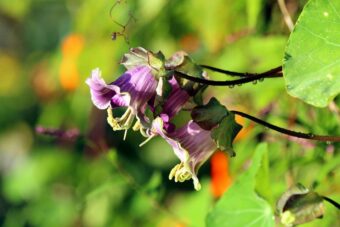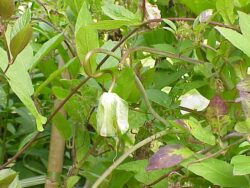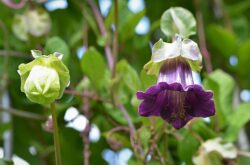In this article, we will be discussing how to grow the half-hardy annual climbing plant Cobaea in containers. Cobaea is a genus of flowering climbers that tend to grow rapidly. It is found to grow naturally in South American countries from Mexico to Peru. It is named after the Spanish Jesuit priest and naturalist Father Barnabe Coba. They can grow up to 3m in one season, where the alternate lobed, green leaves that occur in pairs are produced. Along the stems, tendrils are produced that support the plants as it grows upwards.

From summer to early autumn, 7.5cm large, ball-shaped flowers with predominantly curved stamens are produced singly along the stems. They can be bright green, violet or purple in colour. In some areas such as New Zealand, it is classified as weeds, so do be careful if you are growing this plant.
The plant has bright oblong, green leaves and along the stem, cup-shaped flowers appear that are pale green when they start to open. They either turn purple or white as they mature. The flower heads when they appear have a foul scent, but as they open a floral honey scent will be noticed.
Find out how to grow this vigorous climbing plant in containers.
GROWING COBAEA IN CONTAINERS
They are very easy to grow from Cobaea from seeds and this is the best way to do it. You can also buy garden-ready plants if they are available.
GROWING COBAEA FROM SEED
Cobaea will readily grow from seed if you plant them in February indoors. First, fill 7.5cm pots with seed sowing compost and then place the large flat and tough seed vertically near the surface of the compost. Just cover the seed and place them in a warm location after covering them with some Clingfilm.

After 3 to 4 weeks the seeds should have germinated, although this can be erratic. It is best to start individually in pots because the vines can get entangled pretty quickly and will become difficult to separate. You will need to use sticks to support it as it grows. In Mid-May, you will need to harden the plants off before planting them outside in a container in late May.
At this stage, you can treat and plant the shop-bought, garden-ready plants and home-reared seedlings in exactly the same way.
As the vine gets very large and heavy, you will need to choose a heavy and large container, such as a large and deep half-barrel. No matter what you choose make sure it has plenty of drainage holes at the bottom. To this add a2cm layer of gravel to aid drainage even further. On top of this, add multipurpose compost until 5cm below the top rim. They are not fussy about what type of compost it is grown in, as long as there is compost has some slow-release fertilizer added in, as this will give it an initial boost and help it to bloom throughout the growing season.
Dig a hole at the centre of the container slightly bigger than the root ball it came in the original container. Drop the plant on so that the top of the root ball is at the same level as the top surface of the compost. Backfill with the growing media so that no gaps remain using more compost if you have to.
Firm the plant in and water well. One tip is to place the container near a wall, trellis or pergola before you fill it.
GROWING CONDITIONS

They need full sun to do well and they need at least six to eight hours or they will not do well. As it is a large plant, it will need to be watered regularly allowing it to dry out somewhat between waterings. The best time to water is when 5cm below the top surface of the compost feels dry to the touch.
Young seedlings are prone to temperature drops and should never go below 10 degrees Celsius, so do not bring them out too soon.
The plants cannot take temperatures below 7 degrees Celsius and so must be brought inside to survive in early autumn. There are problems with this, as first the container is large and heavy to move and second, you will get better results with fresh seeds every year. If you can provide heat, the vines can be grown in a greenhouse where they will stay evergreen all year round.
Do not over-fertilize as this will encourage too much green growth and sparse flowering, This is why only use a teaspoon of slow-release fertilizer at planting to get it through the growing season, should be enough. In the UK it is best to dispose of plants in late autumn.
PESTS AND DISEASES
When the plants are young they can be attacked by aphids. The best way to deal with them is to blast them off with jets of water or if it is very bad you can use a systemic insecticide.
As the plant matures it can be attacked with red spider mites, which are best dealt with by the use of appropriate miticide.
VARIETIES TO GROW
The one species to grow is Cobaea Scandens which has long violet, bell-shaped flowers. You may get a disappointing show of flowers if the drainage is poor, if you underwater or if you fail to harden them off before planting. A noted yellow-green variety is ‘Alba’.
CONCLUSIONS
In this article, we have discussed how to grow the beautiful flowering and scented Cobaea in containers. They are such vigorous plants that you can get more than 3m growth in one season but they are so delightful to look at. They are easy to grow, easy to look after and general pests and diseases free, provided you are on top of any aphid attack.
If you have any questions or comments that you wish to make on growing Cobaea in containers. Please do so in the comment box below.
Happy Cobaea growing.
